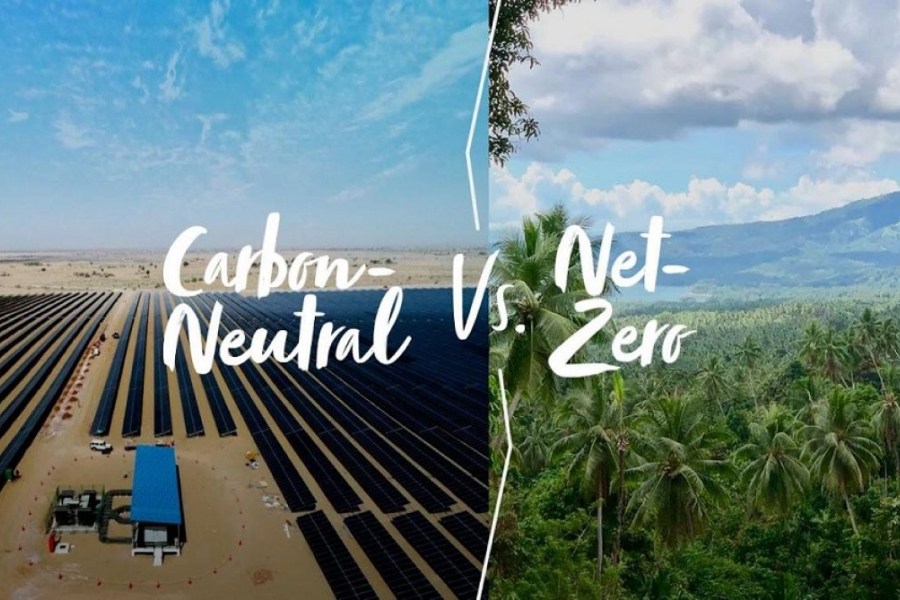In this post, we will clear the air by defining each of these terms, explaining the differences between them, and then providing some examples of each. We will also give you the rundown on which one is better.
What is the difference between carbon neutral and net zero?
Carbon neutrality refers to the practice of balancing any carbon dioxide (CO2) that is emitted by removing an equivalent amount of CO2 from the atmosphere.
Net zero emissions refer to the practice of reducing greenhouse gases (GHGs) as close to zero as possible, then offsetting the rest by removing an equal amount of GHGs from the atmosphere.
The key difference is that carbon neutral deals only with CO2, while net zero deals with all greenhouse gases, including CO2. Net zero also focuses on reducing emissions as much as possible and only offsetting as a last resort, whereas carbon neutral allows companies to continue emitting as long as they balance it out with carbon offsets.
Confusingly, some people also talk about “net zero carbon”, which is the practice of reducing CO2 emissions as much as possible and offsetting as a last resort. There is also “carbon negative”, which is when an organization removes more CO2 from the atmosphere than it produces. These nuances can be difficult to grasp, so let us look at some examples.
Examples of carbon neutral and net zero
Imagine your company has a fleet of gas-powered vehicles. Driving these vehicles produces greenhouse gas emissions including CO2, methane (CH4), and nitrous oxide (N2O). You want to reduce your carbon footprint, so you decide to keep these vehicles on the road and purchase carbon credits to offset the CO2 emissions. That would make your fleet carbon neutral, even though your fleet would still be producing a significant amount of GHG emissions.
Net zero, on the other hand, might involve replacing some of these gas-powered vehicles with electric vehicles (EVs) that produce fewer tailpipe emissions, then offsetting any remaining emissions by removing an equal amount of greenhouse gases from the atmosphere.
Another example would be if your company uses fossil fuels to power its facilities. Planting trees or investing in environmental projects to offset the CO2 emissions from the energy used would help your company become carbon neutral. If you wanted to reach net zero, however, you might first try to switch to renewable energy sources like solar or wind that does not produce as many greenhouse gas emissions while generating energy.
Carbon neutral vs Net zero: Which is better?
As you can see from the examples above, net zero emissions have a few key advantages over carbon neutral. First, net zero has a larger scope than carbon neutral. Instead of just focusing on carbon emissions, it includes all greenhouse gases.
This is important because carbon dioxide is only part of the equation when it comes to global warming. Other greenhouse gases like methane and nitrous oxide also contribute to rising temperatures. For example, methane is the second most emitted greenhouse gas in the U.S. While it only makes up about 11% of total emissions, it has an outsized impact on global warming. Nitrous oxide also contributes to global warming by depleting the ozone. These gases are overlooked by efforts to become carbon neutral, but addressed by net zero.
Net zero is also more aggressive toward reducing emissions. Rather than relying on offsets to balance out emissions, net zero focuses on reducing emissions first and only using offsets as a last resort. This is different from carbon neutrality, which is only concerned with the total amount of emissions at the end. In theory, this could allow companies to continue polluting without taking steps to reduce their emissions.
Today, more than 70 countries — including the U.S., China, and the European Union (E.U.) — have set net-zero targets. The U.K., the E.U. and its member states, and at least 11 other countries have already enshrined these goals in legislation.
The bottom line
Both carbon neutral and net zero have been important tools in the fight against global warming. However, as we understand more about what is causing climate change, we are learning that more aggressive strategies are needed to avoid a global disaster.
If you had to pick one strategy over the other, net zero is the better choice. It covers a wider scope of GHGs and takes a more aggressive approach to reduce emissions. It is not just necessary for preventing the worst impacts of climate change, it is also mandatory in many countries.



